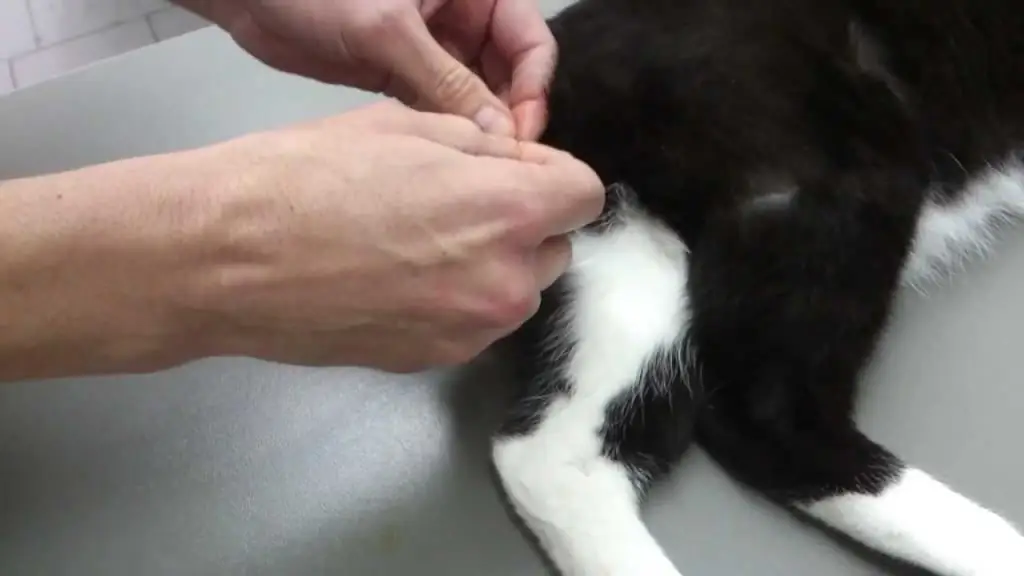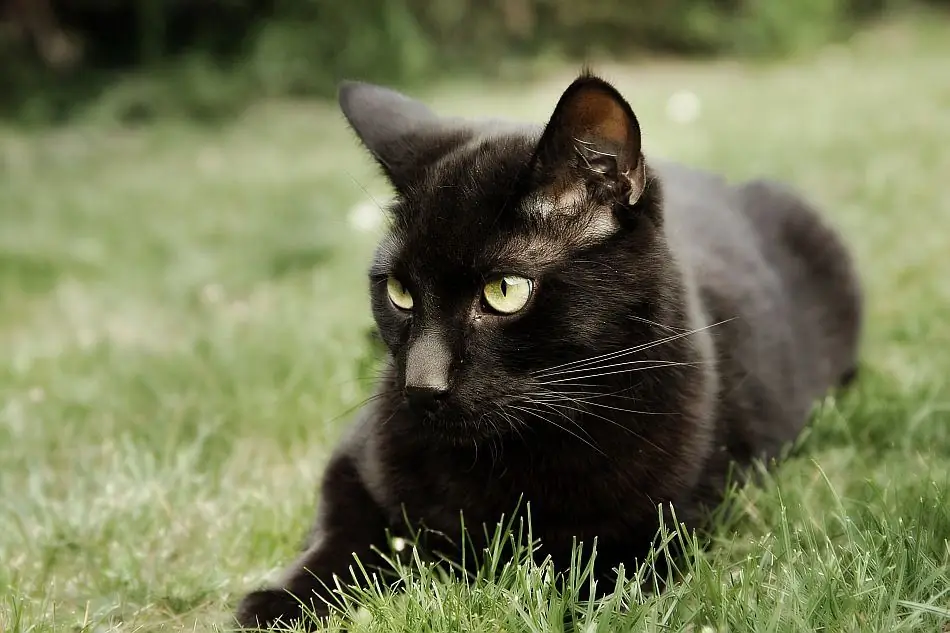2026 Author: Priscilla Miln | [email protected]. Last modified: 2025-01-22 17:55:27
Milk fever, or eclampsia, in cats is a disease with acute neurological symptoms that can develop in pregnant or lactating animals. Most often, this disease affects cats in the early postpartum period. It is important to recognize the disease in time and start rational treatment in order to protect the pet from serious complications and save his life.
Causes and mechanism of disease development
During pregnancy, natural changes occur, in which calcium from the mother's body is spent on the formation of the skeleton of kittens in the womb. Parathyroid hormone is responsible for the absorption and entry of this element into the bones and muscles (it is produced by the parathyroid gland).
Sometimes, at the end of pregnancy or after childbirth, the mentioned gland cannot be rebuilt and provide the cat's increased calcium needs. As a result, only milk is saturated with it, but not the body of the animal. These processes explain the mechanism of pathology, and their study allows us to understand how eclampsia develops in cats after childbirth. Treatment of the disease involves rest and saturation of the body with calcium.

The development of eclampsia is facilitated by irrationalnutrition and diseases of the digestive system, due to which the absorption of calcium is disturbed. Most often, this pathology is diagnosed in primiparous animals. Cats that have many kittens are prone to it, as they have even higher calcium requirements.
Symptoms
There are a number of characteristic signs that occur with a disease such as eclampsia in cats after childbirth. Symptoms in an animal on the first day after the appearance of offspring are usually the following:
- restless behavior;
- dry mucous membranes;
- strange attitude towards their kittens (instead of caring, the cat may run away from them or constantly drag them from one secluded place to another);
- muscle twitching;
- shortness of breath;
- constantly wide pupils and no reflex constriction even in bright light.

Later, these manifestations of eclampsia may be joined by convulsions, fever up to 40 ° C and above, fainting. At the first alarming symptoms, the cat should be shown to the veterinarian to establish an accurate diagnosis and develop a treatment regimen. It is important for the doctor to conduct a differential diagnosis with epilepsy and tetanus and assess the severity of the disease. This is to determine if the animal needs hospital treatment or can be cared for at home.
Animal First Aid
The cat needs emergency care before the vet arrives. This will increase the chances of recovery and a favorable outcome. Since eclampsia in cats can develop withinseveral hours, you need to act quickly. At home, you can help in this way:
- temporarily isolate a sick animal from kittens;
- provide complete peace for the cat;
- in the room where the pet is, there should be subdued light and fresh air;
- high body temperature can be brought down with damp, cool towels or an ice pack wrapped in a cloth;
- in case of convulsions, the animal must be covered with pillows or blankets so that it does not hit or hurt during an attack.

Cubs need to be provided with artificial nutrition, since eclampsia of a lactating cat is a contraindication to natural feeding. The kittens must be kept in a separate room until their mother is fully recovered so that she does not accidentally harm them.
Calcium gluconate treatment
Calcium malabsorption and autointoxication of the body due to the accumulation of postpartum secretions in the uterus lead to such a disease as eclampsia in cats. Treatment at home should be etiotropic, that is, eliminating the cause. The main drug to compensate for the deficiency of the missing trace element is calcium gluconate. After consulting a veterinarian, the medicine can be administered intramuscularly on its own at home.
The dose of calcium gluconate should be determined by the doctor, but on average, to stop an attack of eclampsia, intramuscular injection of 1 ml of a 10% solution with an interval of 40 minutes is recommended untilcharacteristic symptoms.

To eliminate edema, the animal can additionally be prescribed "Prednisolone", and to eliminate muscle spasms - "Drotaverine" ("No-Shpa"). After the removal of acute symptoms, the cat is usually injected intramuscularly with calcium gluconate twice - in the morning and in the evening - 1 ml each for 7-10 days.
What else can you do to help at home?
Because eclampsia in cats is accompanied by the accumulation of toxic metabolites in the body, detoxification therapy should be provided to the animal. At home, this can be done by drinking plenty of water. This method of oral fluid replenishment and elimination of toxins is analogous to a dropper in a hospital.
The cat should be in a quiet place, protected from light and harsh sounds. The animal should not experience tension and stress, as these conditions can lead to deterioration and frequent convulsions. It is necessary to monitor the condition of the mammary glands, check them several times a day for soreness and the presence of seals. If necessary, milk can be slightly strained to prevent the development of a concomitant disease - mastitis.
Restoring cat he alth
Eclampsia exhausts the cat, and even after a complete cure, her body needs careful treatment and support. A pet needs a balanced diet, dairy products should be present daily (ideally, if they make up a third of the total daily food).
It would be advisable to take vitamin and mineral supplements with calcium, which can be selected by a veterinarian. After recovery, the animal should be treated kindly, not teased or awakened if it is sleeping. It is advisable to completely transfer kittens to artificial feeding so that the cat does not develop calcium deficiency again.
In what situations can the disease not be treated at home?
Eclampsia is a disease that, if left untreated, can lead to the death of an animal. A cat can die due to high body temperature (above 41 ° C) or due to brain damage and depression of the respiratory center.
There are signs of eclampsia in cats, which indicate a severe course of the disease and the need for inpatient treatment. If, after the start of therapy, the animal's condition does not improve for a couple of hours, this may indicate the need for an intravenous infusion of the drug.

In cases of a prolonged increase in body temperature, which is not brought down by medication and with the help of home methods, the cat is also recommended to be hospitalized. This must be done to avoid the destruction of protein structures and the development of severe seizures. In the hospital, it is possible to administer drugs under ECG control, which allows you to recognize cardiac disorders in time and start dealing with them.
Prevention
The main role in preventing such a dangerous phenomenon as eclampsia in cats is played by a complete balanced diet during pregnancy. It should not be not only calcium deficiency, but also its overabundance. The intake of high doses of this element with food into the body during the bearing of offspring can lead to malfunctions of the parathyroid gland and become an indirect cause of the development of metabolic disorders in the future.

If the animal was already diagnosed with eclampsia during the last birth, then the interval until the next pregnancy should be maximized. In this case, you should be especially careful about nutrition and be sure to undergo veterinary examinations on time.
Recommended:
What is lactose intolerance and how is it treated?

What is lactose deficiency in infants, every parent should know in order to recognize the symptoms in a timely manner and seek medical help. For children of the first year of life, this pathology can be extremely dangerous. It negatively affects the functioning of the main systems of internal organs. At the same time, the upper layer of the intestine is damaged, the formation of enterocytes is slowed down
How do cats tolerate castration: how long does a cat recover from anesthesia, how does behavior change, rules of care. Food for neutered and neutered cats

Owners of domestic cats often resort to castration. More often than not, this is simply necessary. An adult cat needs at least 8 cats a year to feel good. It is not always possible to give him such an opportunity in an ordinary city apartment. It is for this reason that the deposition procedure can help. But how cats tolerate castration is what worries caring owners. We will answer this and many other questions in the article
How is lichen in children treated? It all depends on the type of disease

Lichen is a very common childhood disease. And this is not surprising - it is easily transmitted from other people or from animals, especially street animals, which the children love to pet so much. Therefore, the question of how to treat lichen in children is asked by many parents. Let's answer it
Understood how cough in children is treated

If the baby gets sick, the mother should not panic, she needs to provide all possible assistance to her child as soon as possible. This article will be useful to those parents who want to know how they treat cough in children
Where do cats go after death: do cats have a soul, do animals go to heaven, opinions of priests and owners of cats

Throughout a person's life, a very important question is of concern - is there life after death and where does our immortal soul end up after the end of earthly existence? And what is the soul? Is it given only to people, or do our beloved pets also have this gift? From the point of view of an atheist, the soul is the personality of a person, his consciousness, experience, emotions. For believers, this is a thin thread that connects earthly life and eternity. But is it inherent in animals?

